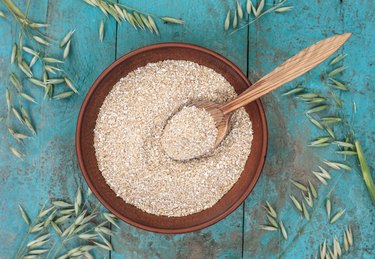
Most of the fiber in whole grain oats comes from the oat bran. Oat bran provides several health benefits to the cardiovascular and digestive systems, and helps to prevent weight gain. The soluble fiber in oat bran also helps keep blood sugar in check.
Tip
Oat bran is high in soluble fiber, which may help to lower cholesterol, control blood glucose levels and improve digestive health.
Video of the Day
Anatomy of Oats
Before processing, whole oat grains consist of a lipid-rich germ surrounded by a starchy endosperm. The germ and endosperm are encased in the bran, which is high in fiber.
Video of the Day
Raw oat bran retains this high fiber, and is a good source of zinc, magnesium, phosphorus, vitamin B1, vitamin E and potassium. According to the USDA Nutrient Database, one cup of raw oat bran has 231 calories, about 16 grams of protein, 6.6 grams of fat and 14.5 grams of fiber.
However, pure oat bran is not normally consumed in that volume. It's often added to other foods or eaten as part of the whole oat grain.
Oat Bran Products
Several oat products contain oat bran, including oat bran cereal. Oat groats are the simplest form of oats with minimal processing. The entire grain is intact, minus the outermost covering called the hull. Steel-cut oats are oat groats that have been cut into smaller pieces.
Steaming whole oat grains and then flattening them between rollers produces the familiar rolled oats. Quick and instant oats are rolled even thinner to allow them to cook quickly. Oat flour can also be ground from whole oats.
Read More: How to Lose Weight on an Oatmeal Diet
Soluble Fiber in Oat Bran
Dietary fiber does not have nutritional content because the body cannot digest it. However, fiber impacts multiple aspects of health, including cardiovascular health, weight management and blood glucose levels.
Oat bran mainly consists of soluble fiber, meaning it dissolves in water. As it dissolves, it forms a gel that moves through the digestive tract slowly. Insoluble fiber does not absorb water and moves through the GI tract quickly. A sudden increase in fiber intake can cause bloating but drinking more water can help because the fiber in oat bran absorbs water.
The key component in oat fiber is polysaccharide beta-glucan. A February 2015 review of oat nutrition research published in the Journal of Food Science and Technology states that beta-glucan has a positive effect on blood cholesterol and blood glucose levels, as well has reducing the risk of some kinds of cancer.
Preventing Heart Disease
The soluble fiber in oat bran can reduce the risk of heart disease because it can decrease low-density lipids in the blood, otherwise known as LDL, or "bad cholesterol." Oat fiber works in two ways: it prevents the absorption of some of the ingested fats and cholesterol in the intestine and it binds with cholesterol, pushing it out of the GI tract in stool.
In addition to lowering LDL, soluble fiber can also help to lower blood pressure. According to the T. H. Chan School of Public Health at Harvard University, people who eat a lot of fiber from oat bran and other whole grains experience a greater reduction in heart disease compared with people who don't get enough fiber in their diets.
Read More: The Best Cereals for Lowering Cholesterol
Controlling Blood Sugar
Despite its high carbohydrate content, oat bran and other oat products help control blood sugar levels by preventing a spike in glucose and insulin release following a meal. The fiber in oats slows down digestion, including the breakdown of complex starches into simpler molecules of glucose.
Without this slowdown, glucose can quickly be absorbed by the intestine and hit the blood stream almost immediately. Slower absorption results in a more gradual rise in blood sugar. Eating oats can also lower the fasting blood sugar results for people with diabetes.
Weight Management and Gut Health
When the soluble fiber in oats absorbs water, it expands in volume in the intestines. This viscous, gel-like fiber fills you up and keeps you full longer because it is digested slowly. When food is digested more slowly, it curbs the appetite, which can help prevent weight gain. Oats also pack a nutritional punch by providing lots of fiber and nutrients without a lot of calories, according to the Mayo Clinic.
The fiber in oat bran is also good for your gut, because it provides food for the "good" bacteria in the small intestine and colon. Fiber adds bulk to stool, which prevents constipation and promotes regular bowel movements.
- Harvard University T.H. Chan School of Public Health: “Oats”
- USDA National Nutrient Database: “Oat Bran- Raw”
- Journal of Food Science and Technology: “Nutritional Advantages of Oats and Opportunities for Its Processing as Value-Added Foods- a Review”
- Harvard University T.H. Chan School of Public Health: “Whole Grains”
- Mayo Clinic: "Dietary Fiber- Essential for a Healthy Diet"
Is this an emergency? If you are experiencing serious medical symptoms, please see the National Library of Medicine’s list of signs you need emergency medical attention or call 911.